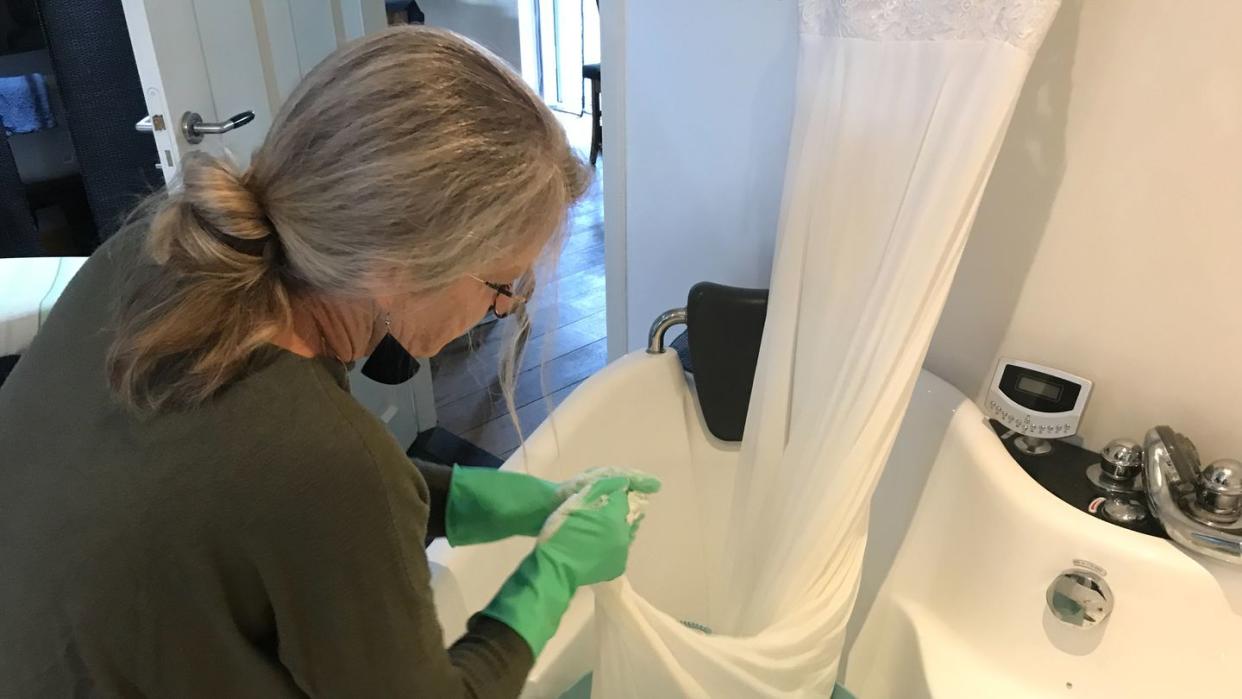This Woman Tried TikTok's Viral "Laundry Stripping" Technique on Her Wedding Dress and the Results Were Undeniable

"Hearst Magazines and Yahoo may earn commission or revenue on some items through these links."
[table-of-contents] stripped
There's a never-ending database of oddly satisfying videos on social media. You can watch people cut soap, squish sand, and whisper into a microphone for hours on end if you want. Our favorite category is cleaning videos: organizing a messy closet, degriming a bathtub, and polishing pots and pans, watching people share their home projects. We still can't forget one of the biggest viral hits of 2020: laundry stripping. The disgusting-but-awesome trend took the internet by storm right just when many people had time at home to try it.
The strip washing cleaning method isn't just super satisfying to watch, but it claims to be incredibly practical. In the OG TikTok videos, users fill their tubs with hot water, throw in a cleaning solution (mostly borax and washing powder), then soak towels, sheets, thrifted clothing, you name it, in the mixture for a few hours. Cut to a shot of a tub full of murky brown or gray water, teeming with the gunk and buildup that seeped out of the fabric. That's it. That's the TikTok. After you strip your laundry, the videos claim it'll be cleaner than ever.
What Exactly Is Laundry Stripping?
Laundry stripping at large is the process of removing buildup—that is, residue from detergents and fabric softeners and minerals from hard water, oil, dirt, and bacteria, among other icky things—from your textiles. The idea is that throwing your towels in the washer simply won't cut it. "Stripping towels helps to eliminate any odors from the fabric and allows the towels to restore their absorbency," says Leanne Stapf, chief operating officer of The Cleaning Authority, a national home cleaning service. "In the end, you’ll find the towels return to a fluffier fabric."
Why Should I Strip My Laundry?
Most people don't need to strip their laundry. You might consider laundry stripping if you have hard water, use fabric softener or dryer sheets, or use homemade soap—they all contribute to a buildup of residue in textiles. The issue with homemade soap is leftover dirt and body oils. "While homemade soap omits chemicals and is often cost efficient, it typically doesn't wash your clothes and linens as effectively as store-bought detergent," says Diana Rodriguez-Zaba, President of ServiceMaster Restoration by Zaba, a Chicago-based cleaning service. With fabric softener liquid and sheets, buildup is the problem. "Fabric softener and dryer sheets are great items to use to make our towels and clothes smell amazing, however they do leave a small layer of film that is nearly invisible," says Justin Carpenter, owner of Dallas-based cleaning service Modern Maids. That film can make towels and sheets look dingy, smell musty, and be less absorbent. Hard water leaves mineral deposits that can have a similar effect.
What Else Can I Strip Wash?
Laundry stripping isn't just for heavy-duty towels, sheets, and bathrobes. You can strip many different types of textiles, even clothing. One TikTok user even strip washed her wedding dress! Just proceed with caution, since clothing is often on the more delicate side of the spectrum. Delicate fabrics like silk should not be strip washed. "Cotton fabrics will need to be stripped more often than synthetic ones, as synthetic fabrics tend to wick away odor and moisture more effectively," says Zaba. "When deciding what to strip and how often to strip it, consider the fiber length and density of the material. Towels with dense fabric and long fibers tend to trap odor, causing excessive bacteria and buildup over time."
How Do I Strip My Laundry?
It's easy—it just takes time. Here's what you'll need:
"Clean" laundry (meaning freshly laundered, either wet or dry)
¼ cup borax
¼ cup washing soda (sodium carbonate)
½ cup detergent laundry detergent
Step One: Fill your bathtub with hot water. Add the borax, washing soda, and laundry detergent, and stir to dissolve. (You can also do this in a large utility sink or bucket, but it's not as easy. To do that, use borax, washing soda, and laundry detergent in a 1:1:2 ratio.)
Step Two: Completely submerge your towels, sheets, or clothing in the mixture and let them soak until the water has cooled, about four to five hours, stirring occasionally.
Step Three: Drain the dirty water (it'll be a satisfying but horrifying murky gray color), then run your items through a rinse-only cycle in the washer. Finally, tumble dry them (without dryer sheets, obviously) and voilà! Your cleanest laundry ever.
How to Strip Wash in a Washing Machine
You won't get to see the dirty water, but laundry stripping in a washing machine is much more convenient than doing it in a tub or basin—there's no lifting soaking wet laundry. If you have a front load washer, choose the hot water setting, a soak option if one is available, and a rinse-and-spin cycle. If you have a top-load washer, choose the hot water setting and the deep-fill option if it's available, and strip wash your items on a soak-and-spin cycle.
Is Laundry Stripping Necessary?
No, it's not. It may be satisfying to watch and potentially great for ultra-dirty or old towels, sheets, and thrifted items you want to be sure are extra clean, laundry stripping isn't a necessity—especially if you use the right amount of laundry detergent, don't overcrowd your washing machine, and clean your washer regularly. In fact, it can cause normal clothing to wear faster than regular washing. Laundry stripping is usually a one-and-done endeavor. As long as you follow good laundry habits moving forward, it's rare that you'll have to strip items more than once.
You Might Also Like

